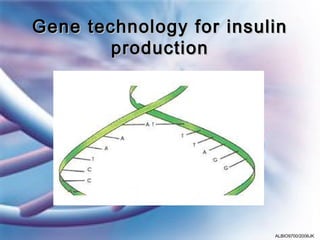01 Gene Technology for Insulin Production
- 1. Gene technology for insulin production ALBIO9700/2006JK
- 2. Steps involved in the genetic engineering of bacteria to synthesise human insulin • Identifying and isolating human insulin gene (cDNA, synthetic DNA or probe) • cDNA insulin genes cut with restriction enzymes (restriction endonucleases) • Gene transferred to a bacterial plasmid • Plasmid containing the human insulin gene are then transferred to the bacterial cells (transformation) • Transformed bacteria are then cloned ALBIO9700/2006JK
- 3. DNA ligase ALBIO9700/2006JK
- 4. The structure of insulin • Chemically, insulin is a small, simple protein. It consists of 51 amino acid, 30 of which constitute one polypeptide chain, and 21 of which comprise a second chain. The two chains are linked by a disulfide bond. Source: Chance, R. and Frank B. - Research, development, production and safety of Biosynthetic Human Insulin. ALBIO9700/2006JK
- 5. • The two genes were added into the lac operon of the β-galactosidase enzyme of E. coli • Methionine triplet code and stop codes are added to the cDNA for each of the insulin gene • E. coli grown in the presence of lactose • Proteins separated from bacteria were treated with cyanogen bromide which cuts the amino acid sequence at methionine • Insulin forms when the mixture of A and B chains is treated to promote formation of disulphide bonds ALBIO9700/2006JK
- 6. • Latest method for manufacturing genetically engineered human insulin use eukaryotic yeast cells • Yeast cells can use eukaryotic promoter sequences and have Golgi bodies, so that they produce insulin that is released already in the correct 3-dimensional conformation to achieve maximum activity in humans ALBIO9700/2006JK
- 7. The advantages of treating diabetics with human insulin produced by gene technology • It is chemically identical to the human insulin, little chance of an immune response • An exact fit in the human insulin receptors in human cell surface membranes, rapid response • Like natural human insulin, duration of response shorter • Overcomes problems related to development of a tolerance to insulin from pigs or cattle • Avoids ethical issues from the use of pig and cattle insulin, religious objections or vegetarian objections • Extraction of insulin from pancreases of pigs and cattle is expensive ALBIO9700/2006JK
- 8. Why promoters need to be transferred along with the desired genes • A promoter is a DNA sequence that contains the information, in the form of DNA sequences, that permits the proper activation or repression of the gene which it controls, i.e. whether RNA is synthesized or not • The promoter contains specific sequences (TATAAT or TTGACA) that are recognized by proteins known as transcription factors. These factors bind to the promoter DNA sequences and the end result is the recruitment of RNA polymerase, the enzyme that synthesizes the RNA from the coding region of the gene. • In prokaryotes, the promoter is recognized by RNA polymerase and an associated sigma factor, which in turn are brought to the promoter DNA by an activator protein binding to its own DNA sequence nearby • Now synthetic DNA can be made rather than rather than trying to make use of natural promoters ALBIO9700/2006JK
- 10. ALBIO9700/2006JK
- 11. • In eukaryotes, the process is more complicated, and at least seven different factors are necessary for the transcription of an RNA polymerase II promoter • Eukaryote promoters may not have the intended effect in prokaryotic cells • When genes are transferred from eukaryotes to prokaryotes, it is essential that a suitable prokaryote promoter is added to the gene before it forms recombinant DNA with the plasmid vector • If eukaryote promoters are to be transferred with eukaryotic genes, into eukaryotic cells of a different species, then care must be taken to ensure that all of the relevant code is included (TATA box and E box) ALBIO9700/2006JK

